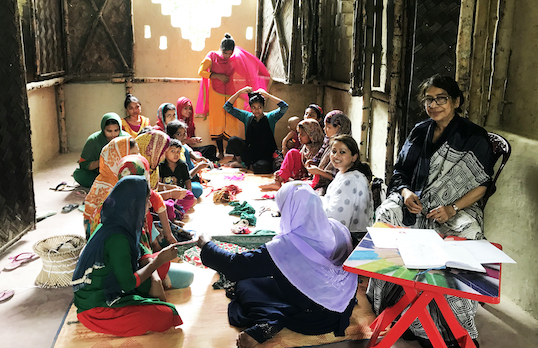South Asian Heritage Month (18 July to 17 August) is now underway, and it is a great time to reflect on what colleagues with roots from India, Pakistan, Bangladesh and Sri Lanka bring to the profession.
The region’s unique history, flair for design and rich and diverse culture has inspired architecture for many centuries, with one key principle underpinning many South Asian architects’ work.
Sevā (sometimes spelt ‘sewa’) or sadaqa translates as ‘selfless service’ and Vinesh Pomal, Senior Architect at ButcherBayley and co-head of year one at Leicester School of Architecture, thinks it's a good time to spread some understanding of the concept, which he says will always be a focus for some South Asian-led practices.
He explains it’s an idea born essentially out of undertaking actions for people without the need for any reward. This could start with your own extended family and when it comes to South Asian families, this could mean living together in intergenerational housing. The concept can also extend into the wider community.
What is sevā or sadaqa?
Fellow Asian Architects Association co-founder Tumpa Husna Yasmin Fellows, Director of interdisciplinary practice Our Building Design, follows the concept of sadaqa (similar to sevā), which means a voluntary, charitable act given through generosity, in order to help improve the lives of the underprivileged.
Tumpa does this by splitting her practice’s community participation projects and activities between the UK and Bangladesh. The charity she has worked for over the last 12 years, the Mannan Foundation Trust, was set up in the UK by members of her own family and named after her late father, who was born in the village of Rajapur.
The completed Rajapur Centre, a community building for women’s literacy and community healthcare, was designed and constructed through community participation with the aim of fostering community empowerment, ownership and self-sufficiency.
“I have attempted to adopt a post-colonial lens in my practice, critically reviewing architecture through participation and working with marginalised groups of women, children and members of the low-income population,” Tumpa explains.
“We work with local crafts, skills and materials, sharing and the communicating design process and knowledge from the Global South that aids adaptation to extreme climate conditions.”
This meant reviving dying skills and crafts using local materials such as bamboo and mud. This approach is at the opposite end of the spectrum to the “parachute projects,” where Western designers fly in and out of the country, with little or no engagement with the local community.
Tumpa led a team of volunteers in London, who offered professional services and raised funding for the project, while local community members were employed for building. From the beginning, the community was involved through participatory workshops and the adoption of simple building techniques that would promote self-sufficiency.
“A number of my current projects and research include working with the diasporic communities in the UK through the lens of de-colonial architectural practice, design methods and proposals, and using some of the practice principles I have developed in Rajapur,” she continues, “to create more equitable public spaces by facilitating the voices of under-represented in our communities.”

Five inspirational South Asian architects
Balkrishna Doshi
Born in Pune in 1927, Doshi became the first architect from India to win the prestigious Pritzer Prize (he won it in 2018). Using concepts he learned from working with Le Corbusier, he became known for designing public spaces and social housing that both reflected and worked with the Indian culture and environment. Doshi was awarded the Royal Gold Medal in 2022.
Charles Correa
One of India’s most famous architects, Correa pioneered modern architecture during recent independence.
Minnette de Silva
Born in 1918 in Sri Lanka, de Silva is regarded as a pioneer of Modern Regionalism (or Critical Regionalism) and was not only the first female architect from Sri Lanka, but also the first South Asian woman to become an associate of RIBA. To find out more about Minnette de Silva, Sumita Singh OBE has written a blog post on her life and legacy.
Yasmeen Lari
Recently awarded the 2023 Royal Gold Medal, Pakistani architect Lari is an advocate of ‘barefoot social architecture (BASA)’, which seeks to revive long-established techniques, building with earth, lime and bamboo and work with underprivileged communities to help ‘achieve climate resilience, sustainability and eco justice in the world’.
Mazharul Islam
Thought by many to be Bangladesh’s most significant architect, Islam’s work began in the 1950s and he is credited with introducing a new culture of architecture into the country. He also displayed a passion for societal change and strong practice ethics.

Why tapping into local knowledge can make a difference
Tumpa adheres to a set of principles drawn from co-production methodology that she says are important if you are to safeguard local communities when practitioners are working with communities abroad or at home.
A lot of local knowledge can be tapped into through engagement and knowledge exchange methods. “I try to accumulate local indigenous knowledge and the indigenous ways methods and adaptations to the climate,” she says.
Tumpa continues: “I see myself as an architect who is a mediator and facilitator of underrepresented voices. The challenging aspect my practice addresses trying to decolonise and expand architectural practice and pedagogy. This means instilling in and teaching the next generation of architects methods that help to redistribute the power dynamics between the architect, client, user, gender, ethnicity, class and income to create a more equitable place for communities to live.”
How sevā can influence and strengthen social cohesion
Vinesh Pomal, who like Tumpa is both in practice and teaches, says Western culture could learn from South Asian attitudes to caring for one another, particularly across generations.
He contrasts the intergenerational home where he has always lived with the Western approach of building care homes outside of town centres, where people can feel isolated. He sees this as the opposite of social cohesion and integrated communities.
Sevā, for him, ultimately starts at home with the family. You can find it expressed in the preferred layouts of homes where the all-important kitchen, the living space and the dining area will all be interconnected – ideally with minimal physical barriers – to accommodate the large family gatherings that happen frequently.
“It comes down to selfless service and looking after people,” he says. “We must put people at the heart of what we do. Asian culture has shown that selfless service is the way forward, whether you are looking after the current generation, new or ageing generations, or contributing through communities, through charitable work or any other type of work that you do.”
Thanks to Vinesh Pomal, Senior Architect, ButcherBayley and Tumpa Husna Yasmin Fellows, Director, Our Building Design.
Text by Neal Morris and Paul Hirons. This is a Professional Feature edited by the RIBA Practice team. Send us your feedback and ideas.
RIBA Core Curriculum topic: Inclusive environments.
As part of the flexible RIBA CPD programme, professional features count as microlearning. See further information on the updated RIBA CPD core curriculum and on fulfilling your CPD requirements as a RIBA Chartered Member.









